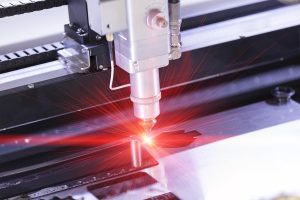Imagine knowing enough about Earth’s atmosphere to predict climate trends, or knowing enough about a hurricane to get the right people evacuated. Consider a time when advances in medical procedures retire the scalpel to the museum. Even in precision-manufacturing, laser technology advancements can potentially bring consumer costs down because of its efficiency.
We can trace the birth of lasers right back to the first two decades of the 20th century. That’s when Albert Einstein figured out the quantum theory of light and photons (in 1905) and the mechanism of stimulated emission (in 1917)—the two key components of laser science.
It was another four decades before the first practical laser appeared. The theory was figured out in 1958, with the first laser being built in 1960. At that time, lasers were thrilling examples of cutting-edge science. In the 1964 film Goldfinger, James Bond was almost chopped in half by a laser beam. Apart from theatrics, no one else had any idea what to do with lasers. They were described as “a solution looking for a problem.”
Today, we all have lasers in our homes and offices with CD/DVD players, and laser printers, and in the stores where we shop (in barcode scanners). Our clothes are cut with lasers and we send and receive emails over the Internet with signals that lasers fire down fiber-optic cables. Whether we realize it or not, all of us use lasers all day long, but how many of us really understand what they are or how they work?
Understanding how laser technology works can be explained with simple physics. The difference between ordinary light and laser light is like the difference between the ripples in the bathtub and waves on the ocean. The faster the water is moved in the tub, the ‘waves’ get bigger and bigger. If it were possible to repeat the same action in the ocean, the waves would become like tidal waves in size. Likewise, with laser technology. The light waves start off with weak light and keeps adding more energy so the light becomes ever more concentrated.
At UKA, we design precision lenses for a wide range of lasers. These lenses can be designed to fit into instruments used in the medical field, manufacturing, the military and aerospace.
In the medical field doctors routinely use lasers on their patients’ bodies. for everything from blasting cancer tumors and cauterizing blood vessels to correcting problems with people’s vision (laser-eye surgery, fixing detached retinas, and cataract treatments all involve lasers).
The military has long been one of the biggest users of this technology, mainly in laser-guided weapons and missiles.
Laser Technology has evolved in leaps and bounds from this post in 1964: The New York Times suggested that “a laser beam could, for example, carry all the radio and television programs in the world plus several hundred thousand telephone calls simultaneously.”
Universe Kogaku designs and manufactures optical lenses for laser technology, security, high tech and electronic applications. We stock 1000’s of standard lens assemblies and can custom design a solution for scanners, CCTV, CCD/CMOS, medical imaging, surveillance systems, machine vision and night vision systems.